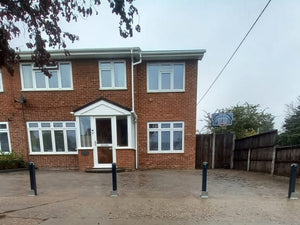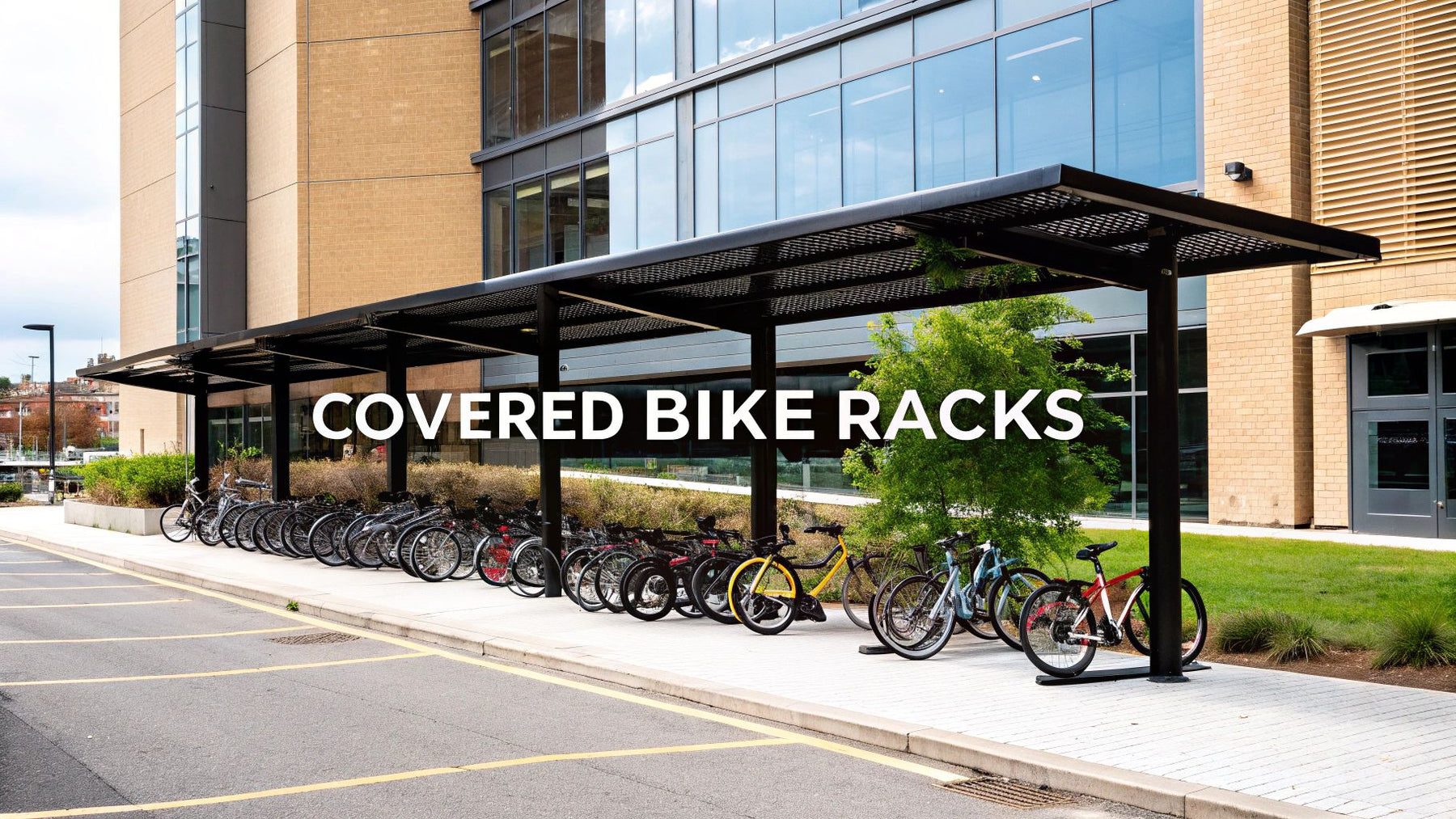
Your Expert UK Guide to Covered Bicycle Racks
Ever stared at your bike chained to a post and wondered if it'll still be dry—or even there—when you get back? You're not the only one. As a family-owned business making security products right here in the UK since 1972, we've heard it all. The best covered bicycle racks are the perfect two-for-one solution, acting as a tough shield against both the notoriously fickle British weather and the constant worry of theft. They are the ideal form of cycle storage for any public or private space.
Why Covered Bicycle Racks Are Essential in the UK
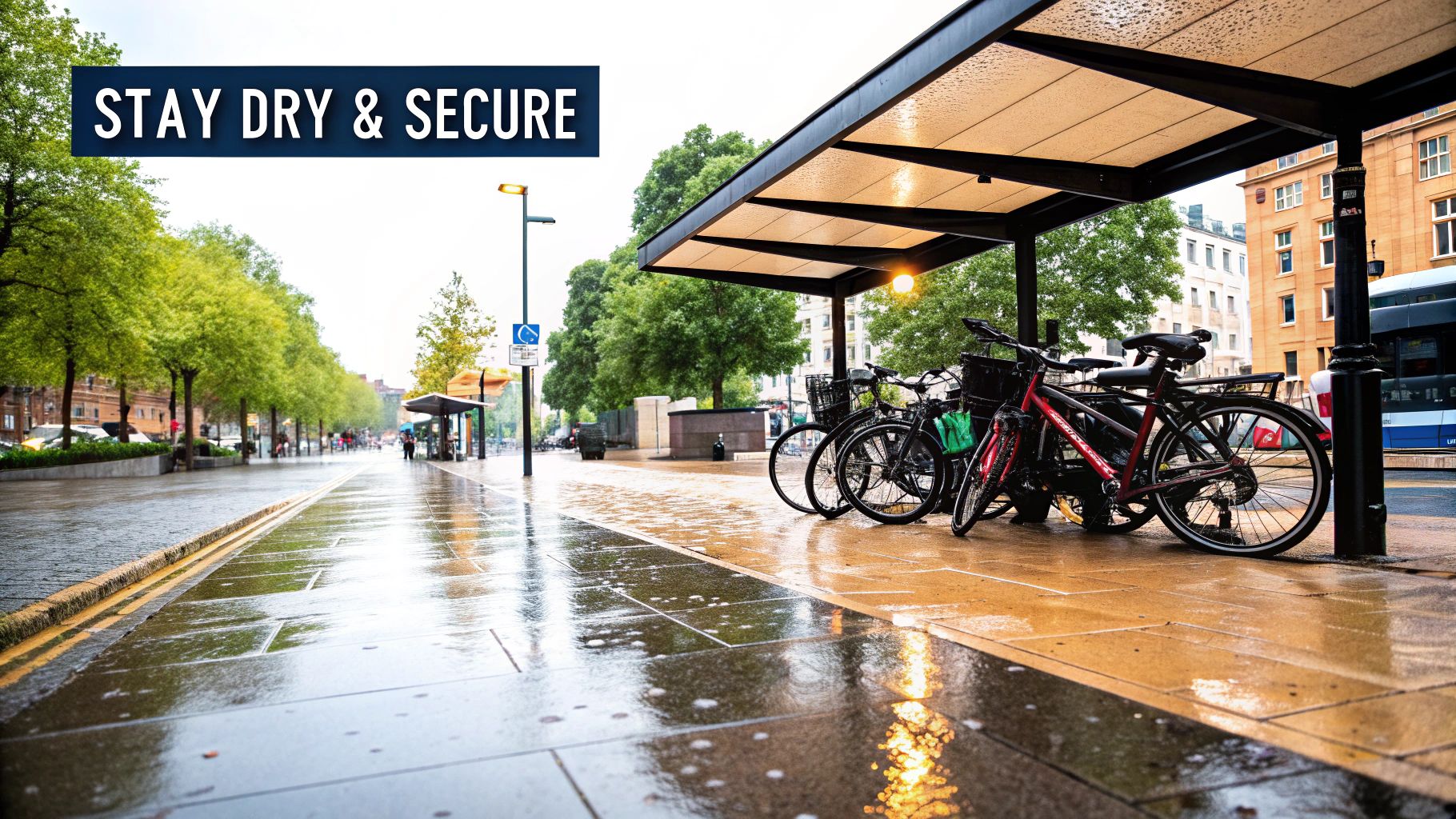
If you cycle in Britain, you know two things for sure: the weather is unpredictable, and bike theft is a real headache. Leaving a bike out in the open, even for a bit, is a gamble with its condition and its safety. This is exactly why covered cycle storage has gone from being a 'nice-to-have' to an absolute must-have for any business, school, or public area.
A good shelter does a lot more than just keep the rain off. It creates a dedicated, organised spot that actually encourages more people to get on their bikes, knowing their ride will be safe, secure, and just as they left it.
More Than Just a Roof
Think of a covered bike rack as a proper, secure parking garage, but for cyclists. Its main job is to protect bikes from all the things that cause damage over time.
- Rust and Corrosion Prevention: Nothing wrecks a bike's chain, gears, and frame faster than constant exposure to rain and damp air. A shelter provides robust vehicle security against the elements.
- Component Protection: You might be surprised by how much damage the sun can do. It can crack saddles, fade paint, and make plastic parts brittle.
- Enhanced Security: A well-lit, designated shelter is a massive turn-off for opportunistic thieves. It’s a far cry from a lonely railing on a poorly-lit street.
This push for better cycling infrastructure has become a big deal nationally. Over the years, government schemes aimed at promoting cycling have really driven the demand for covered racks. The UK's Department for Transport has pumped serious money into improving cycling facilities, which includes installing secure, sheltered bike parking.
As a family-owned business that's been manufacturing British-made security solutions since 1972, we've seen first-hand the difference these installations make. We've worked with countless organisations and have plenty of stories about how we're helping local councils facilitate the impact of cycling on UK towns and cities. Providing proper cycle storage isn't just about protecting property; it's an investment in a greener, healthier future for everyone.
Exploring Different Covered Cycle Storage Solutions
Picking the right kind of covered bicycle rack isn't just about what looks good; it's about finding the perfect match for your space, security needs, and how people will actually use it. Not all cycle storage is made equal, and understanding the differences is the key to a smart investment that will serve cyclists well for years to come.
Think of it like buying a vehicle. You wouldn't buy a delivery van for the school run, and the same logic applies here. Let's break down the main options you'll come across.
Open-Sided Shelters
These are the versatile workhorses of the cycle storage world. An open-sided shelter usually has a solid roof and back, but the sides are either fully or partially open. This design hits a sweet spot between weather protection and easy access.
It’s a popular choice for offices, schools, and retail parks where people need to park and grab their bikes without any fuss. They do a brilliant job of shielding bikes from rain and sun while keeping everything visible, which naturally puts off thieves. Because they feel so open and welcoming, they get used more often.
Fully Enclosed Compounds
When security is your number one priority, nothing beats a fully enclosed compound. These are essentially secure cages or rooms, often built with mesh or solid walls, a roof, and a lockable gate. Access is usually controlled with a key, fob, or code, meaning only authorised people can get in.
You'll often see these at transport hubs, large blocks of flats, and high-value workplaces where bikes might be left for a long time, sometimes even overnight. The peace of mind they offer is unmatched, creating a serious barrier against both theft and vandalism.
Space-Saving Vertical Racks
So, what do you do when you need to store a lot of bikes but you're tight on floor space? This is where vertical and two-tier racks really shine. These clever designs let you store bikes one above the other or hang them vertically against a wall.
This approach dramatically increases how many cycles you can squeeze into a small area, making them perfect for city centre spots, underground car parks, and the basements of apartment buildings where every square metre is precious. While users might need to put in a little extra effort to lift their bike, the space you save is a game-changer. Looking into different outdoor bike storage ideas can spark some inspiration for even the trickiest locations.
This chart compares the average security level and space efficiency of these three popular covered bicycle rack solutions.
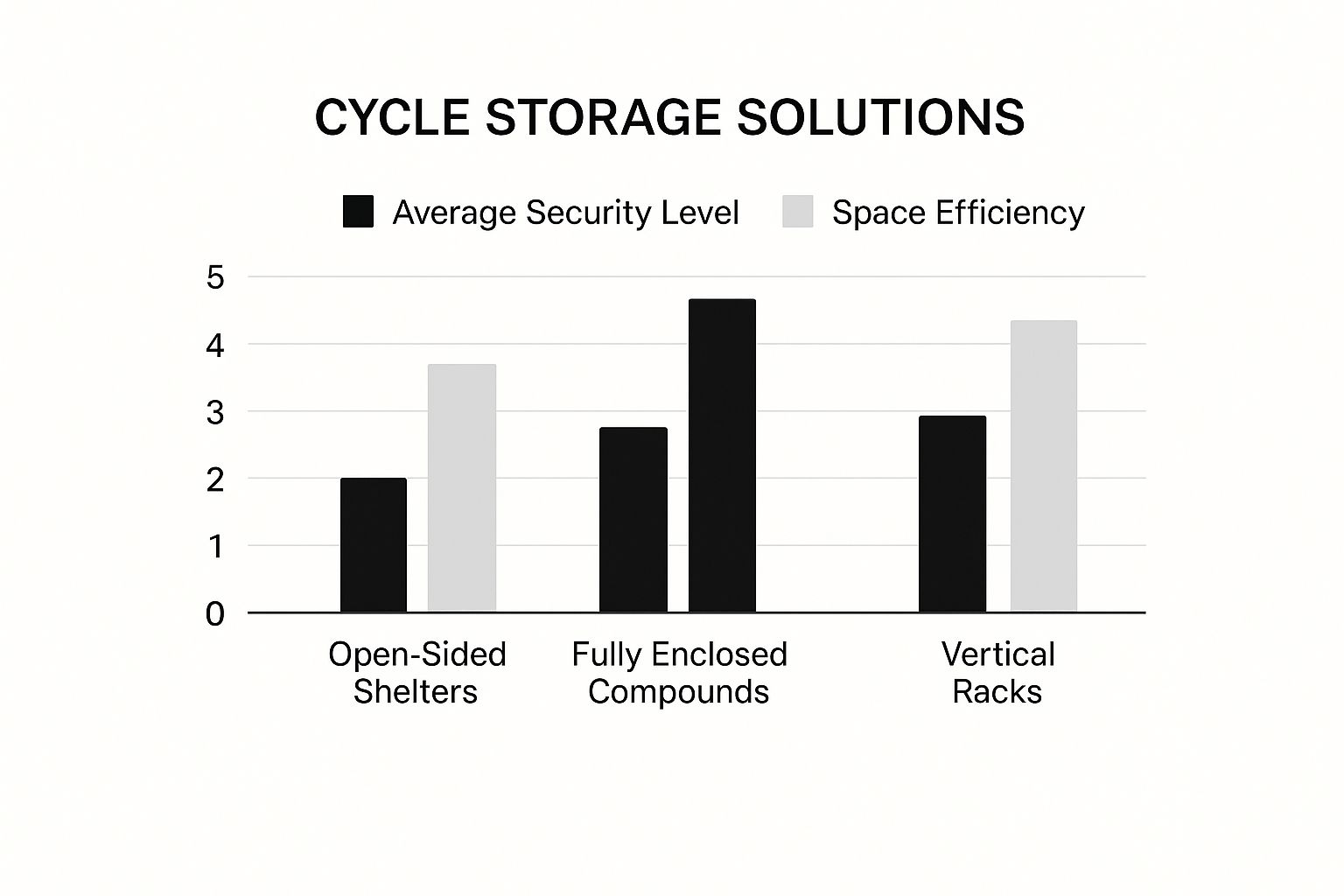
As the data shows, enclosed compounds provide the highest security, while vertical racks offer the best space efficiency, helping you prioritise what matters most for your site.
Choosing the Right Materials for UK Weather
A covered bicycle rack is only as good as the materials it’s made from. This is especially true when it has to stand up to the relentless damp of the British climate. The secret to a long-lasting, low-maintenance investment that looks great for years is choosing the right combination of steel, finishes, and roofing.
As a UK-based manufacturer with roots going back to 1972, we’ve learned exactly what it takes to build cycle storage that truly endures. We focus on materials that offer the best defence against rust, impact, and whatever else our weather decides to throw at them.
The Steel Framework: Your First Line of Defence
The frame is the backbone of any shelter, and for strength and durability, steel is the undisputed champion. But it’s the finish that really counts. Not all steel finishes are created equal when it comes to battling the elements.
-
Hot-Dip Galvanised Steel: This is our gold standard for weather protection, and for good reason. The process involves dipping the entire steel frame in molten zinc, creating a tough, bonded coating that prevents rust from the inside out. It’s the ultimate ‘fit and forget’ solution for maximum longevity.
-
Powder-Coated Steel: For a finish that combines solid protection with a sharp look, powder coating is an excellent choice. A dry powder is applied to the steel and then cured under heat to form a hard, durable layer. This finish is resistant to chipping and fading and can be produced in a wide range of colours to match your company branding or architectural style.
For the absolute best of both worlds, a frame can be galvanised first and then powder-coated. This combination offers unbeatable rust prevention with a polished, professional look that lasts.
Roofing Materials: Keeping Cyclists Dry
The roof of a covered bicycle rack needs to be tough. It has to handle everything from heavy downpours and hail to the odd stray football.
Polycarbonate is our preferred material for roofing. It's incredibly impact-resistant—virtually unbreakable—and offers natural UV protection. This is a bigger deal than you might think, as it helps prevent bike saddles and paintwork from fading over time.
This robust material ensures that while the shelter protects the bikes, it can also protect itself from damage. That guarantees a long service life with minimal fuss. Our popular 8-Person Premium Shelter, for instance, combines a fully galvanised frame with tough polycarbonate panels for a truly durable, set-and-forget solution.
To help you weigh up your options, we've put together a quick comparison of the most common material choices for your covered bicycle racks.
Material Comparison for Covered Bicycle Racks
This table breaks down the key materials used in our cycle shelters, giving you a clear idea of what each one brings to the table in terms of durability, looks, and upkeep in the UK climate.
| Material | Key Benefit | Best For | Maintenance Level |
|---|---|---|---|
| Galvanised Steel | Unbeatable rust and corrosion resistance | Maximum longevity in wet climates | Very Low |
| Powder-Coated Steel | Durable, customisable colour finish | Branding and aesthetic requirements | Low |
| Polycarbonate | High impact and UV resistance | Roofing and side panels | Very Low |
Ultimately, the right materials ensure your bike shelter isn't just a purchase for today, but a reliable, long-term asset for your property.
How to Plan Your Bike Rack Sizing and Capacity
Getting the sizing right for your covered bicycle racks is one of those jobs that seems straightforward until you actually start measuring. If you go too small, you'll end up with a daily tangle of handlebars and pedals. Go too big, and you're just wasting valuable space. The real trick is to plan not just for today's needs, but for tomorrow's as well.
Before you do anything else, grab a tape measure and get a feel for your available space. You need to think in three dimensions here, considering not just the length and width of the area but also the height – that's especially important if you're planning to install a shelter.
Don't forget to account for a clear path around the racks. Cyclists need enough room to comfortably wheel their bikes in and out without bumping into walls, cars, or each other.
Calculating Your Required Capacity
Once you know the space you're working with, the next job is figuring out just how many bikes you need to accommodate. It's tempting to just count the cyclists you have right now, but it pays to think ahead and anticipate future growth.
- Current Demand: Start with a simple headcount of the current cyclists at your workplace, school, or residential building.
- Future Growth: Are you expecting to hire more staff? Has the local council been pushing new cycling initiatives? A good rule of thumb is to plan for 10-20% more capacity than you currently need. This ensures your investment stays useful for years to come.
Planning for future demand is always the most cost-effective approach. It’s far easier and cheaper to install a slightly larger shelter and rack system from the outset than it is to add an extension later on.
Understanding Spacing Requirements
The secret to a bike park that people actually want to use is proper spacing. Cramming racks too close together is a false economy—if it’s a pain to use them, people simply won't.
Standard guidelines recommend a minimum of 750mm between each bike stand to give people adequate space. You also need a clear aisle of at least 1.5 metres for easy movement. This is what prevents scratched frames and tangled handlebars, making the whole experience much more pleasant for cyclists. For larger projects, our range of commercial bike racks is designed to meet these exact specifications.
Maximising Space with Smart Configurations
If you're working with a tight area, don't worry. There are some clever ways to maximise your capacity without creating a cramped, unusable space.
One of the most effective solutions is a high-low rack configuration. By staggering the height of the wheel holders, you can position bikes much closer together without the handlebars clashing. It’s a simple design trick, but it can significantly increase the number of bikes you can fit into a limited footprint.
By taking the time to plan your sizing and capacity properly, you can turn a potentially tricky task into a straightforward exercise, creating a secure and practical facility that cyclists will appreciate and use every single day.
Why Professional Installation Is Non-Negotiable
A high-quality, British-made covered bicycle rack is a brilliant investment in security, but its strength is only ever as good as its foundation. While a DIY approach might seem like a way to cut costs, professional installation is the only way to guarantee your shelter performs exactly as it should, giving you long-term security and durability for years to come.
Frankly, it’s the difference between a secure asset and a potential liability.
Since 1972, we've seen it all. Our in-house, experienced teams understand that every site is unique, which is why we never take a one-size-fits-all approach to fitting. We make sure every installation is done right the first time, giving you complete peace of mind.
Ground Surfaces and Correct Anchoring
The single most critical factor in a secure installation is how the covered bike rack is anchored to the ground. Different surfaces demand different methods, and getting this wrong can seriously compromise the entire structure.
- Concrete: For existing concrete pads, we use heavy-duty anchor bolts drilled deep into the foundation. This creates an incredibly strong, permanent fixing that can withstand significant force and prevent tampering.
- Tarmac and Paving: These surfaces are much softer and need a different technique. We typically excavate the area and pour dedicated concrete foundation pads, into which the shelter’s legs are securely set. Bolting directly onto tarmac is a recipe for failure.
An improperly installed shelter can be vulnerable to high winds or even a determined thief. Our professional assessment ensures the correct anchoring method is used for your specific ground conditions, guaranteeing stability and security. This commitment to quality is why every installation we complete is backed by our comprehensive 2-year warranty.
The Risks of Improper Installation
A poorly fitted shelter isn't just less secure; it can be downright dangerous. Incorrect anchoring can lead to instability, posing a safety risk to users and their bikes. Beyond the immediate benefits of expertise, professional installation is often essential for adhering to relevant building regulations, ensuring your covered bicycle rack meets all legal and safety standards.
Choosing our professional installation service means you're not just buying a product; you're investing in a correctly-fitted, compliant, and secure solution handled by our own trusted team from start to finish. It’s the non-negotiable final step in protecting your property and providing a safe facility for cyclists.
Enhancing Security with Smart Add-On Features
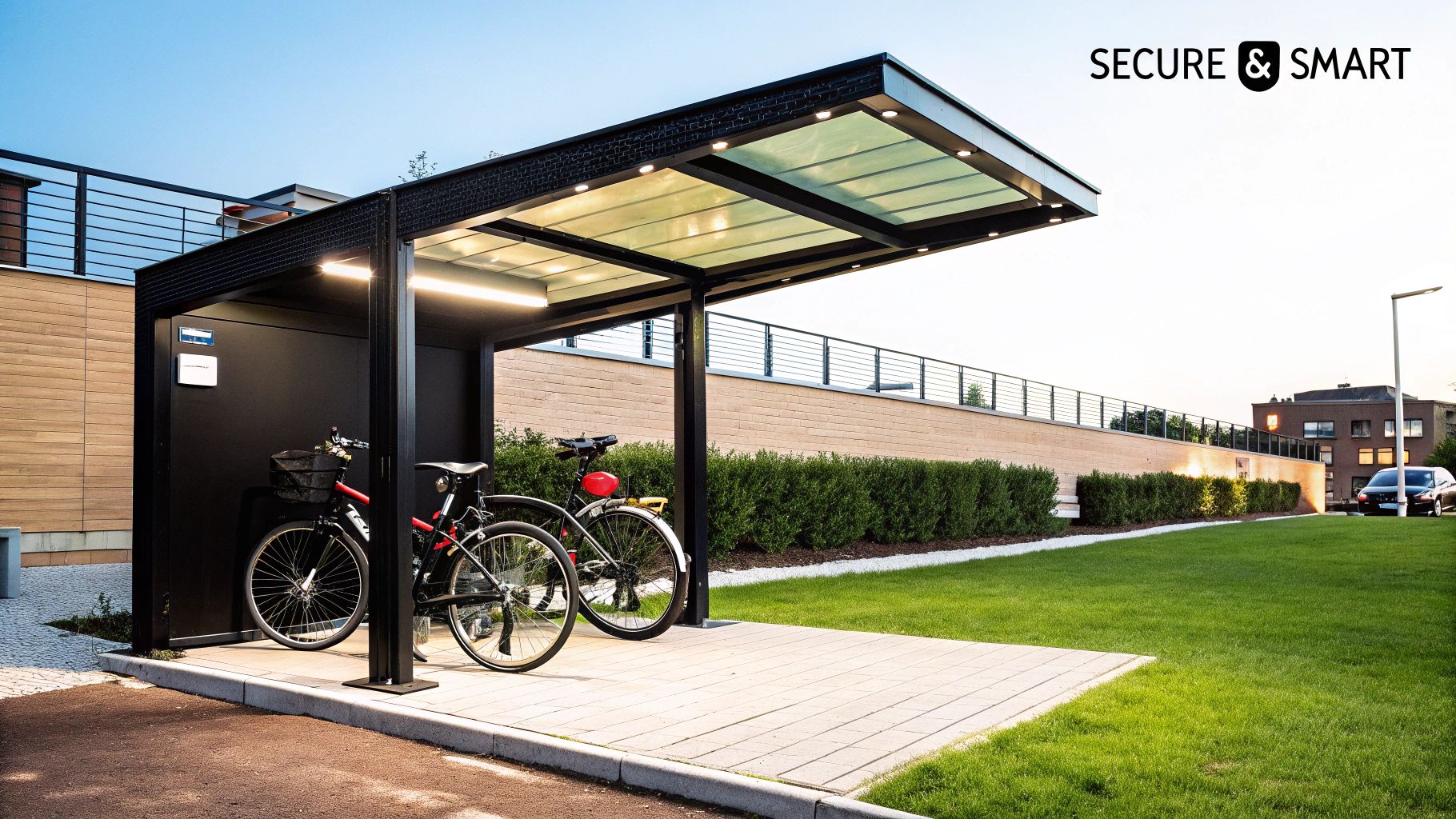
A truly great covered bicycle rack does more than just shield bikes from the rain. To get people to actually use it, a cycle storage solution has to take the entire experience into account, from convenience right through to personal safety. It’s the smart, practical add-ons that turn a good shelter into an essential piece of infrastructure for any site.
This is where our experience since 1972 really comes into play. We know from decades in the business that a dark, isolated shelter won’t get used, no matter how well-built it is. That's why we always look to integrate features that build user confidence and provide layers of security far beyond a simple roof and frame.
Integrated Lighting for Safety and Visibility
One of the most effective security upgrades is also one of the simplest: good lighting. A well-lit area is a massive deterrent to thieves and makes a huge difference to the personal safety of cyclists arriving early in the morning or leaving after dark.
We often recommend motion-activated LED lighting systems. They’re energy-efficient and ensure the area is brightly lit precisely when someone is there, drawing attention to the user and making them feel much safer.
Advanced Locking Mechanisms
While a shelter provides a secure location, cyclists still need a solid point to lock their bike to. This is where integrated features provide that final, crucial layer of security.
- Integrated Locking Hoops: These are welded directly onto the frame or stands, offering a secure, fixed point for cyclists to use their own locks.
- Gated Access Control: For fully enclosed compounds, we can install gates with coded locks, key fobs, or swipe card access. This restricts entry to authorised users only, giving everyone total peace of mind.
A great facility combines robust driveway protection principles with user-friendly design. It should be as easy as possible for the right people to use, and as difficult as possible for the wrong people to exploit.
The growing demand for high-quality covered bicycle racks is directly linked to the boom in cycling across the UK, as more and more people choose bikes for commuting and leisure. As our towns and cities work to ease congestion, this trend is only being helped by investment in better cycling infrastructure. You can read more about the global trends in the bicycle racks market to see just how these facilities are evolving.
For high-risk locations, CCTV integration offers the ultimate reassurance, providing round-the-clock surveillance. By combining these smart features, we deliver complete, secure, and convenient cycle storage facilities that truly serve the modern cyclist.
Your Covered Bicycle Rack Questions Answered
We know that investing in covered bicycle racks is a big decision. To help you feel confident moving forward, we’ve put together answers to some of the questions our team hears the most from customers across the UK.
Do I Need Planning Permission?
Good question. For many standard shelters, you often won’t need planning permission, as they fall under 'permitted development rights'.
However, it’s not always that simple. It can depend on the shelter's size, where exactly it's going on your property, and if you’re in a special area, like a conservation zone. We always suggest a quick chat with your local council just to be safe, and our experienced team is on hand to offer guidance on what’s usually required.
How Long Does Installation Take?
The timeline really hinges on the complexity of the job. A straightforward, surface-mounted rack going onto an existing concrete base? Our professional team can have that done and dusted in just a few hours.
On the other hand, larger covered bicycle racks that need brand new concrete foundations dug and set will likely take one to two days. We always give you a clear, honest timeline with our quotes and work efficiently to keep disruption to a minimum.
Galvanised vs Powder-Coated Steel?
Both are fantastic, durable options for your cycle storage, but they offer slightly different benefits.
Think of hot-dip galvanising as the ultimate shield against the British weather. It coats the steel in a protective layer of zinc for exceptional, long-lasting rust protection. For pure weather resistance, it's the top choice.
Powder coating gives the steel a hard, coloured finish. It offers great protection while also giving you the chance to match your company branding or building aesthetics. For the best of both worlds – maximum durability and a sharp look – we can provide a product that's galvanised first and then powder-coated.
At Bison Products, we’re here to help you find the perfect, British-made cycle storage solution. Explore our full range of covered bicycle racks today.

